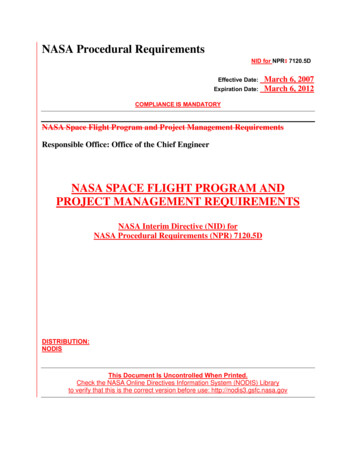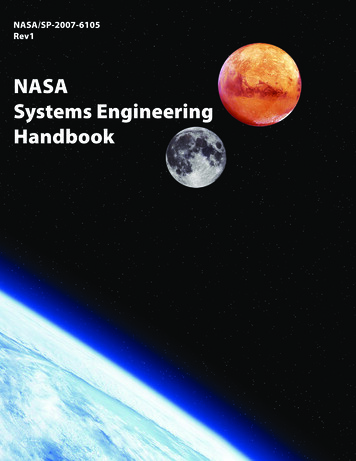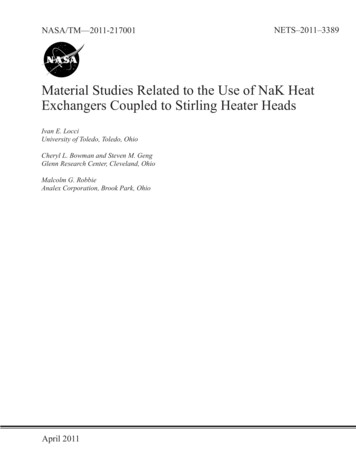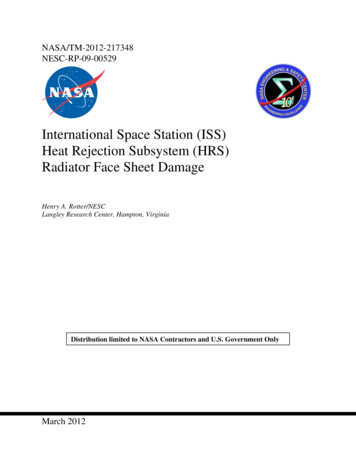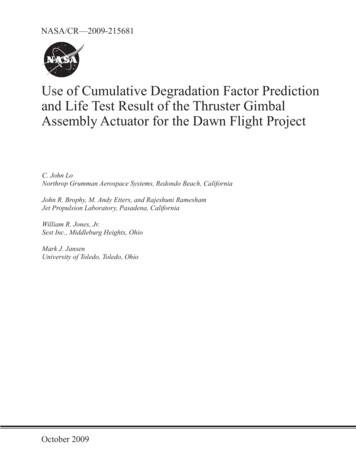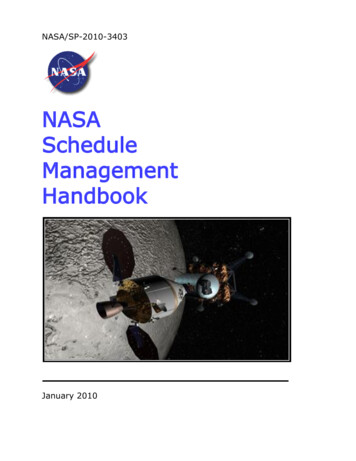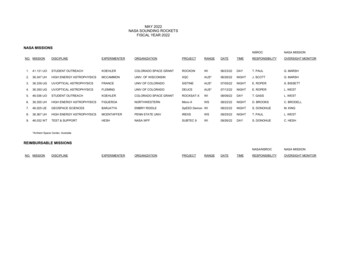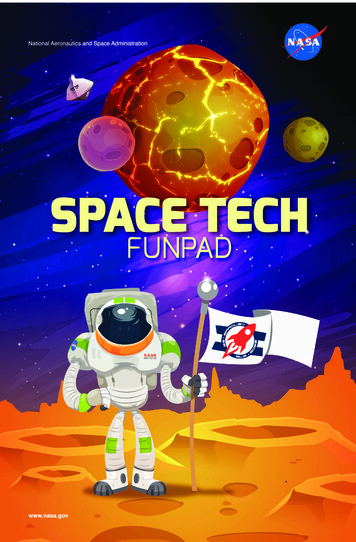
Transcription
NASA ResourceSlide Set
The Universe is vast and always changing. It includesplanets, stars, galaxies, and all of space, matter, andenergy. Looking at the night sky, you can sense howsmall Earth is in the vastness of space. A million Earthscould fit inside the Sun. The Sun is the only star in ourSolar System but is one of over 100 billion stars in a spiralgalaxy we call the Milky Way. Our Solar System is locatedabout 2/3 of the way out from the galaxy’s center.Astronomers think that most of the stars in our galaxymay also have planets orbiting around them.2
Milky Way Galaxy
ConstellationsIn contemporary astronomy, a constellation is one of 88regions of the sky that cover the entire celestial sphere.The ancient Sumerians, and later the Greeks (asrecorded by Ptolemy), established most of the northernconstellations in international use today.Orion is a prominent constellation located on the celestialequator and visible throughout the world. It was named afterOrion, a hunter in Greek mythology. The image below outlinesthe region near Orion's sword that was surveyed by NASA's SpitzerSpace Telescope (white box). The view on the left is from a visiblelight telescope and the view on the right shows infrared light (IR).The bright spot in both images is the Orion nebula, our closestmassive star-making factory.
Galaxies GaloreIndividual galaxies form into clusters. Galaxyclusters form into superclusters. Scientistsestimate that there are more than 100 billiongalaxies in the universe. This deep field view ofthe universe was taken by the Hubble SpaceTelescope. All but 4 specks in this “Hubble DeepField” image are entire galaxies, each of them with100 billion stars.
Andromeda Galaxy – 23 Million Light-Years Away
Our Solar System has one medium-sizedstar at the center, four small inner rockyworlds, and four large gaseous outer worlds.It formed 4.6 billion years ago from thegravitational collapse of a giant interstellarcloud of gas and dust.
Our Solar System
The vast majority of the Solar System's mass is inthe Sun, with most of the remaining masscontained in Jupiter. It also contains at least 140moons and millions of comets and asteroids.The asteroid belt, which lies between the orbits ofMars and Jupiter, mostly contains objectscomposed of rock and metal, like the terrestrialplanets. Beyond Neptune's orbit lies the Kuiperbelt and Oort cloud, home to comets.
Planets
Our SunTo the unaided eye, space appears to be a vast, darkvoid, and the Sun a tranquil sphere of light. But in fact,space is not empty, because Earth’s orbit lies withinthe atmosphere of our dynamic Sun.The space between the Sun and planets is filled withthe Solar Wind, a continuous stream of ionized gas, orplasma, that pours out of the Sun at 200 tons persecond and a million miles per hour. The Sun’ssurface can also explode, sending charged particlesand electromagnetic radiation into space that canimpact Earth and cause magnetic storms.
Solar Probe’s Journey to the Sun
Earth is the 3rd planet from the Sun. It formed 4.5billion years ago. Earth is often called the “BluePlanet” because about 70% of its surface iscovered by water. Earth’s thin atmosphere isabout 20 kilometers high. Earth is located in theSolar System’s Habitable Zone, where liquid watercan exist at the surface. It’s the only planet in ourSolar System where we know for certain that lifehas evolved.
Earth:A Blue Marble
Our Sky
Northern Lights from the International Space StationThe Northern Lights -
The Moon (Latin: Luna) is Earth's only natural satellite, and the fifthlargest moon in the Solar System. It’s the only celestial bodyhumans have travelled to and landed on.The dark and relatively featureless lunar plains humans can clearlysee when the Moon is full are called maria (singular mare), Latin forseas, since they were believed by ancient astronomers to be filledwith water. These are now known to be vast solidified pools ofancient basaltic lava that flowed into the depressions associatedwith impact basins that formed by the collisions of meteors andcomets with the lunar surface.The lighter-colored regions of the Moon are called highlands, sincethey are higher than most maria. Several prominent mountainranges on the near side are found along the periphery of the giantimpact basins, many of which have been filled by mare basalt.
Earth’sMoon21
Mars has long fascinated astronomers andscience fiction writers. While life hasn’t been foundon Mars yet, new research is happening thereevery day. The planet has seasons, polar caps,dormant volcanoes, canyons, and impact craterslike Earth.The surface of Mars is dry, rocky, dusty, and rustcolored. That’s because its surface is covered withactual rust: oxidized iron is common in the surfaceminerals!
Mars – The RedPlanet
The Mars Curiosity Rover discoveredsmooth, water-worn Martian stones: telltalesigns that liquid water once flowed on Mars.Scientists think that these are deposits ofsmall deltas fed by rivers flowing down fromthe crater rim to the north into a lake to thesouth. This interests scientists because alllife needs liquid water to survive. Was thereonce life on Mars?
Curiosity Rover on Mars
InSight is a robotic lander designed to study the interior of theplanet Mars. The name is a backronym for Interior Explorationusing Seismic Investigations, Geodesy and Heat Transport. Themission launched from Vandenberg Air Force Base on California'sPacific coast aboard a two-stage Atlas V launch vehicle on 5 May2018 and landed on the surface of Mars at Elysium Planitia on 26November 2018.InSight's objective is to place a stationary lander equipped with aseismometer and heat transfer probe on the surface of Mars tostudy the planet's early geological evolution. This could bring newunderstanding of the Solar System's terrestrial planets —Mercury, Venus, Earth, Mars — and Earth's Moon.
Mars Insight Lander
Juno is a NASA space probe orbiting the planet Jupiter.It’s operated by NASA's Jet Propulsion Laboratory. Thespacecraft was launched from Cape Canaveral Air ForceStation on August 5, 2011 and entered a polar orbit ofJupiter on July 5, 2016. After completing itsmission, Juno will be intentionally deorbited into Jupiter'satmosphere.Juno's mission is to measure Jupiter's composition, gravityfield, magnetic field, and polar magnetosphere. It will alsosearch for clues about how the planet formed, includingwhether it has a rocky core, the amount of water presentwithin the deep atmosphere, and its deep winds, whichcan reach speeds up to 380 mph.
Juno spacecraft near Jupiter
International Space StationThe space station is a scientific research facility orbiting 250 miles(400 km) above Earth. Astronauts live there and conductexperiments. It orbits Earth 16 times a day, or once every 90minutes. It travels at 17,500 mph (nearly 5 miles per second).Including its solar panels, the whole station is a little bigger than afootball field. The area where astronauts work and live is the size ofa five-bedroom house.There are usually three to six astronauts on board at all times,representing several different countries. Though they have differentnative languages, astronauts on the ISS mostly communicate inEnglish and Russian. The ISS has been continuously inhabitedsince November 2000.
International Space Station
EarthriseThe tumultuous year of 1968 saw escalation of war, riots in thestreets, and assassinations of leaders. During this time of upheavalback on Earth, NASA gave the world hope through its Apollomission to the Moon. Apollo 8 was the first mission ever to takeastronauts to a world beyond Earth.Crewmembers James Lovell, Frank Borman and Bill Anderslaunched on Dec. 21, 1968, and reached lunar orbit three dayslater, on Christmas Eve. The unexpected view of our world risingabove our desolate neighbor was caught on film in one of the mosticonic pictures in history, Earthrise from Moon orbit. Back on Earth,splashdown occurred on December 27, 1968.
Apollo 8 Earthrise Photo
NASA’s Apollo Mission to the MoonOn Jan. 9, 1969, NASA announced the prime crew of the Apollo 11 lunar landingmission (lunar module pilot Buzz Aldrin; commander Neil Armstrong; andcommand module pilot Michael Collins). Later that year in July 1969, the crewlaunched to the Moon and into history. Their flight objectives included thescientific exploration by the lunar module crew; deployment of a televisioncamera to transmit signals to Earth; and deployment of a solar wind compositionexperiment and seismic experiment package.Apollo 17 was the final mission of NASA's Apollo program. It launched onDecember 7, 1972, with a crew made up of Commander Eugene Cernan,Command Module Pilot Ronald Evans, and Lunar Module Pilot Harrison Schmitt.Apollo 17 was the first night launch of a U.S. human spaceflight and the finalmanned launch of a Saturn V rocket. The photo below shows Eugene Cernanaboard the Lunar Rover.
The surface of Mars is dry, rocky, dusty, and rust-colored. That’s because its surface is covered with . Mercury, Venus, Earth, Mars —and Earth's Moon. Mars Insight Lander. Juno is a NASA space probe orbiting the planet Jupiter. . a five-bedroom house. There a

